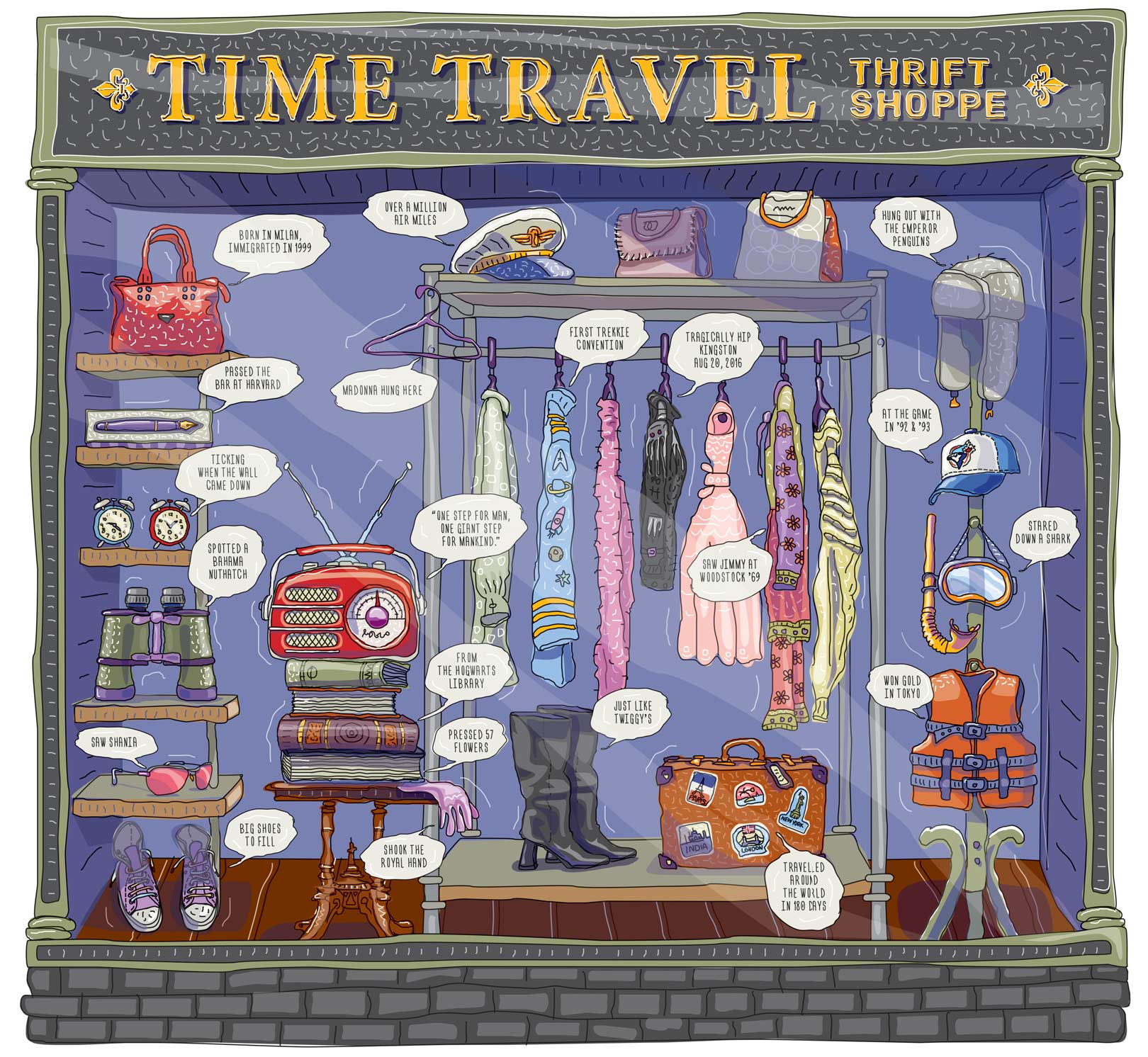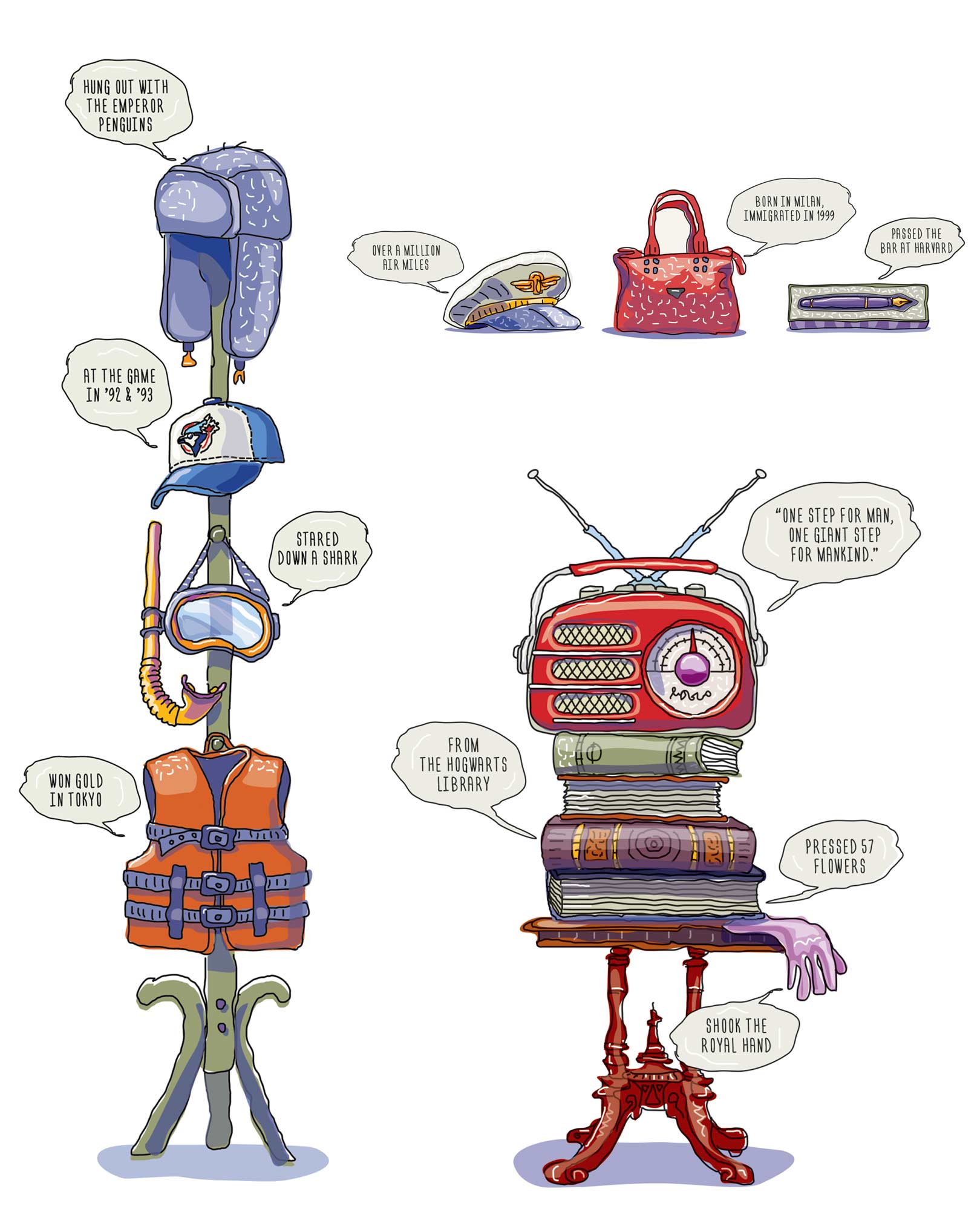

Out with the drab and careworn. Thrift stores today are bright and colourful and sell everything from workwear to Armani. And there are more of them around than ever.
The woman from the yellow house knocked on her neighbour’s door. “There’s something I want to show you,” she said and made her way into the kitchen, dug her treasure out of a nest of tea towels in her bag and triumphantly stepped back from the table. “Look, it’s just like yours!” “That’s a Baccarat crystal champagne glass.” The neighbour’s hand trembled as she picked it up. “They cost $250. Where did you get it?” “That thrift store in Trenton. I paid two dollars,” she said with a certain smug satisfaction. The neighbour sighed. Such are the treasures that send shivers up the spine of a bargain-savvy shopper. Thrift stores have been around forever, and now they are so popular, so plentiful, that “thrift” – a good plain noun – has become a verb. To go thrifting, to buy used, no longer carries a stigma. Scouring thrift shops is touted as one more way to save the planet. It’s first-stop shopping among the young, and increasingly a necessity for many families as the cost of living escalates. And thrifting is big business. Little Port Hope has 15 stores that sell “second-hand” items, and one chain brought in $9 million in revenue in 2022. Everyone has their favourite. Thrift stores come in all shapes and sizes: the traditional pokey little shop staffed by white-haired volunteers, the midsize well-curated, well-displayed stores on the main streets of small towns, and now the for-profit chains with outlets in shopping malls.
RISING FROM THE ASHES
It was the middle of the night last September when smoke billowed and flames shot through the roof of Beyond the Blue Box, the biggest and best-known thrift store in Cobourg. The largest of their three buildings – full of clothes, books, old sporting equipment and who-knows-what-else – was razed to the ground. People gathered and wept.
The original thirty-year-old Blue Box was a thrift store with a chaotic charm – you never knew what you might find inside. When Cobourg’s D’Arcy Place, an institution for developmentally disabled adults, closed in the mid-90s, many of its 100 or so residents had nowhere to go, nothing to do. A key part of the mandate of Beyond the Blue Box was to provide employment to many of those men and women. When the store burned down, nineteen men and women were out of work. The organization regrouped remarkably quickly and is now running two stores on the main street of Cobourg; but with a little more than half the former square footage, they have had to pick and choose what donations they can accept. “Now we have to be more curated than the public would like,” says Jane Stevenson, manager of the Blue Box for more than 20 years.
“We just don’t have the space anymore.” But Stevenson is frank: “Our mandate is to serve everyone. We’re not going to become a fashion boutique.”
They rescued a few things from the fire, and to raise a little money they took a table at the Firefighters Museum art and antique show. One of the bigger items was an old Fender Malibu guitar – price $285. Midway through the day Stevenson looked up and saw Neil Young and his wife, actress Daryl Hannah, out for an afternoon of antiquing. Young looked at the guitar, then wandered off. Stevenson, never shy, followed him, told him the story of the fire and asked if he would sign it as a fundraiser. He did and she tucked it away safely. Twenty minutes later Daryl Hannah came back. “Is it sold?” she asked. “Neil wants to buy it.” Not only did Young buy the guitar, but he said he would sign and send one of his own guitars as a fundraiser.
Unique among thrift stores before the fire, Beyond the Blue Box used to sell items by the pound. Now they don’t have the space for the weigh-scale, but they promise it will be back. Beyond the Blue Box knows that their clientele are not well-heeled matrons looking for a better-priced winter coat; rather, they serve people without much money who are truly in need of a bargain.
WHERE THERE’S A WILL…
Tineke Bouma started Belleville’s Thrift Store twelve years ago. The Belleville Christian School needed money to stay afloat and Bouma wanted to help. But it was plain that unless the thrift store could clear $30,000 or more in a year it wouldn’t be worth the effort. The shop began in a tiny end unit in an out-of-the-way shopping mall (people talked about “shopping in a closet”), but they made their revenue goal. They later moved to a unit more than four times the size, giving them not only more floor space but the luxury of a lunchroom and a sorting table. With one paid employee, their current success rests on volunteers who sort and “care for” the donations. If a dress looks a little grubby it is taken home and washed; one woman in her eighties even comes in after the store is closed to sew on missing buttons and repair split seams.
Those special volunteers and contacts are vital. Bouma cultivated a good relationship with a man who knew his precious metals, and she regularly goes to see him with any piece of jewellery she suspects might be worth a penny or two. “My best was a dirty, dark necklace – it looked like a long key chain. Turned out it was gold and was worth $1,100.” The metals man bought it on the spot.
Bouma did her homework and learned how to run a business. Belleville’s Thrift Store went from $30,000 in annual revenue to more than $100,000. “Every square foot of the store has to earn its keep. If something is not selling, it’s out the door.” At the same time, she keeps prices low.
Profits from Belleville’s Thrift Store go to the school, but it is not a charity. Canada Revenue Agency has been cracking down on charitable designations. A useful rule of thumb for shoppers: if tax is added when the cashier at any thrift store tallies up your purchase, the store is not a charity. What has become clear is that most customers are not particularly interested in the cause the store supports – it’s all about the shopping.
There is a mutually supportive relationship between all the stores. Before the fire, Beyond the Blue Box operated on the same street as the Humane Society thrift store and the Horizons of Friendship shop.
WINDOW SHOPPING
With the increase in business comes new sophistication: Second Helpings, the Big Brother Big Sisters thrift store, knows the value of location. They used to be on a Port Hope side street until a plumbing problem rendered the premises uninhabitable. They moved to a recently vacated store on the main street, and business boomed. They also hit pay dirt with the filming of the Stephen King movie It, which used a lot of Port Hope locations. Second Helpings stood in for the town’s pawn shop, with King himself making a cameo appearance as the storekeeper. International visitors come in asking if this was really the place.
Gwen Hudson, Second Helpings’ manager, has a background in retail and uses it in her window displays. They are changed every couple of weeks and carefully themed – 1970s hockey pictures hang over artfully placed Bauer skates and a pile of carefully folded winter blankets; a celebration of baking features a pile of very new cake tins, an earthenware jug full of wooden spoons and Pyrex baking dishes. The window displays pay off. During Covid, when no one could shop in person, Second Helpings would get messages from window shoppers: “Could you put that blue vase next to the candlesticks aside for me, please?” – proving the worth of a well-appointed display.
Hudson also knows her customers. If someone donates an Armani shirt, it is likely to end up in the Port Hope store. A good sturdy Mark’s work shirt will be diverted to the store in Colborne, where the clientele is more “outdoorsy.” Everything on display – the china, glass, jewellery – is polished and gleams. There is an upholstered chair in the change room, and where some retail stores will cram a couple of dozen items on a rack, Hudson will aim for just a dozen; less is more. Then there is spotlighting – a long black satin gown with a sequined bodice draped with a white boa hangs alone on a panelled door. That will sell quickly.
Thrifting today is a business. Whether your goal is to save the planet or save your pennies, there are treasures to be found in our neighbourhood thrift and vintage stores.
In the fine tradition of high-end retail, the saleswomen – all volunteers – get to know their customers. A doctor’s wife comes in on Tuesdays to see her favourite vendeuse. As for prices, books are now $4 each, and a Canada Goose parka hanging on the wall behind the cash register normally retails for $700 – Second Helpings has it priced at $500.
At the Blue Box, children’s books are 50 cents each, $1 at Belleville’s Thrift Store and as mentioned, $4 at Second Helpings. And if that Canada Goose parka had ended up at Beyond the Blue Box, it would have been priced between $300 and $350.
There is, for the most part, a mutually supportive relationship between all the stores. Before the fire, Beyond the Blue Box operated on the same street as the Humane Society thrift store and the Horizons of Friendship shop, which supports social justice in Latin America; Petticoat Lane, the store in support of the local hospital, is just up the road. “I send customers to the other stores all the time,” says the Blue Box’s Jane Stevenson. And the other stores helped the Blue Box get back on its feet after the fire.
While the shops don’t compete with each other for business, Stevenson is clear: “the competition is for the donations.”
BARGAINS, BARGAINS… BARGAINS?
Shopping thrift stores is supposed to be cheaper, but as with retail, you’ve got to pick and choose to find the real bargains. Recently there have been complaints that thrift store prices have gone up too much. Second Helpings advertised a new donation of high-end menswear on Facebook and drew the comment: “Probably $100 per. Hardly a thrift store.” Gwen Hudson says it flat out: “We can’t afford to give stuff away anymore. Customers are different now than they were 10 years ago. They are not interested in anything that looks second hand. Thrift stores are more curated these days.”
A background in merchandising is increasingly common among thrift store managers. The manager of the Talize store in Belleville had a 26-year career running Walmart stores before he switched.
The Canadian-owned Talize, with 14 stores in BC and Ontario, is the newest of the for-profit “thrift” chains. The Belleville store with 44 employees and 6 managers operates out of the old Zellers store just off the 401. Most mornings there are ten people lined up when the doors open. Value Village, its American-owned counterpart, is a few stores down.
THE FOOD CHAIN
About half the donations that come in the door make it to the shop floor, according to Gwen Hudson. (Some stores, like Beyond the Blue Box, accept a higher percentage.) Everything is vetted for saleability; there can be no chips on the china, no faded patterns; a shirt will be given a five-second inspection – a rip or a stain and it’s rejected. Most thrift stores now check prices against Etsy and eBay. Beyond the Blue Box gives donated paintings and drawings the once-over with Google Lens. One click and they know if they’ve discovered a lost Tom Thomson or maybe a Manly MacDonald. Of the 50 percent of donations that do make it to the shop floor, half of those sell.
Talize talks a lot about “fashion sustainability” in its advertising. When Doug Scott, manager of the Belleville store, talks to job applicants or young people shopping, they tell him it’s the sustainability, the recycling, that matters to them. But the recycling only goes so far. The store, well-organized and immaculate, puts 13,000 items out every week and sells more than half of them.
Their sales volume is comparable to Winners. What’s left is bundled and baled and sold by the pound to Cerebral Palsy for Kids. Second Helpings in Port Hope does the same thing. Beyond the Blue Box donates their unsold items rather than selling them. Their goal is to help people with disabilities. Jane Stevenson says, “We don’t sell our leftover clothes.”
THE FOOD CHAIN CONTINUES
“After the thrift stores, everything ends up in ginormous warehouses in Toronto,” says Joan Greaves. The warehouse locations are known only to people in the business. Pickers move in and comb through everything again. “It’s all part of the chain.” Greaves and her husband Matt Joly run Little Underground, a vintage store in Cobourg. She goes into Toronto once a week and digs for the unique and bizarre – a US Air Force camouflage shirt, scarlet and purple crinolines, leather Fonzi jackets – anything from the 70s or 80s, and if she’s lucky, earlier. Toronto is big in the vintage business. “Every time I’m in the city there are picker teams from Australia and Japan, pulling stuff and shipping it back.” And vintage is not cheap. Greaves sells a heavy suede and fur jacket for $150, a “real” Hawaiian shirt for $60, a leather vest for $90. That said, in Toronto the same things might be three times as much.
What isn’t “picked” from those warehouses in Toronto gets shipped to the developing world. A few years ago a Canadian visitor to northern Uganda took a stroll down a very narrow path in the long grass to the Nile river to fish. Suddenly a 10- year-old boy grabbed the Canadian’s arm. “This is hippo path. Careful, the hippo she comes up the path and she will not stop.” The visitor stared in disbelief. It wasn’t what he was saying, it was what he was wearing; this caretaker of the hippo path had on a Toronto Blue Jays t-shirt – likely part of a shipment of discards from those used clothing wholesale warehouses. At least one piece of clothing from Canada had found a good home. Regrettably, millions of tons are incinerated and three times as many go to landfill. The supply overwhelms the demand even here at home.
Thrifting today is a business. Whether your goal is to save the planet or save your pennies, there are treasures to be found in our neighbourhood thrift and vintage stores; community needs are met and causes are funded by the charity and not-for-profit shops. So spring-clean your closet and your bookshelves, get rid of that hideous vase from Aunt Miranda, take it all down to your favourite thrift store and feel good.
TREASURE HUNTING
There’s thrifting to save money – simply buying what you need; then there are the goosebumps that come when you spy a treasure: a Le Creuset casserole dish at the back of a shelf, a Chanel label hidden on a crowded clothes rack, or a tarnished silver tray that turns out to be Tiffany sterling.
From the sublime to the ridiculous, here are a few real-life treasures found by imaginary but entirely believable bargain hunters while shopping at the many vintage and second-hand stores in our region:
- A martial arts aficionado scored a black vintage shirt with a full body photo of Bruce Lee, muscles rippling with red dragon adornment.
- A young-at-heart disco queen danced her way home in a pair of Saturday Night Fever knee-high white boots.
- A savvy antique dealer snapped up an 1885 black marble clock complete with working chimes.
- An aspiring horticulturist bought ceramic bedpans repurposed as plant holders, perhaps hoping they would produce super plants.
- A fashion trendsetter took home a gold-embroidered hot pink Indian salwar suit, proving there’s something for everyone.
- An off-the-grid shopper outfitted their waterfront cabin with 20 different vintage paraffin lamps.
- A young bride discovered the dress of her dreams – a vintage Victorian white satin and lace wedding gown that fit her perfectly.
Thrift store volunteers are wonderful people who have been known to – if you ask nicely – put something away for you. They are also impervious to surprise – more than one thrift store volunteer has grown used to selling women’s underwear to the region’s growing community of cross-dressers.
HAVE YOU FOUND A TREASURE AT A THRIFT SHOP?
Send along a note telling us about your find and we’ll print the top treasures in our next issue. info@watershedmagazine.com
Story by:
Karin Wells
Illustration by:
Charles Bongers


